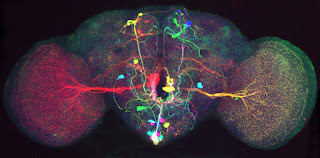This weeks lecture is very fascinating to me, especially as an engineering major. I've always been excited to work in the Aerospace industry and I'm happy to say I will be doing so once I graduate in 2 weeks. Starting from the basics, Nicolaus Copernicus was fascinated by astronomy and was one of the first to describe our Solar system in which Sun was the center of it. Technology progressed with telescopes making space exploration go to new heights.
 |
| God's Eye |
Much of space exploration now can be attributed to science-fiction novel and magazine influence, such as contributions fro Chesley Bonestell. These science-fiction fantasies help popularize space exploration and opened up possibilities that space travel could achieve. Popular media, from television to movies, also played a role into space exploration.
 |
| The Jetsons |
Art was also made to see the what integration it can have in the space programs, such as the Cosmic Dancer by Kathleen Ford. The idea is to see the affects of weightlessness on art when in space. The geometry of the piece allowed for different orientations and angles when viewing in order to achieve different perspectives.
 |
| Orbital Debris Progression |
Of course, some use space as a way of expression, specifically the harm that is around them. Kathleen Ford talks about how artists are taking an interest in zero-gravity and the feeling of weightlessness. This can be contributed to the heavy burdens of war and destruction ans using zero-gravity as a way to break from the forces that hold people down. Richard Clar uses art to show how space debris can be harmful to future space travel as well as the future state of Earth. His art depicts the debris that is orbiting around Earth, and the pictures are quite concerning seeing all the colored areas that debris circle around.
Whether it is for political statements or encouraging space-exploration, art has influenced space studies in a very progessive manner.
References
Bonestell, Chesley. "Bonestell - Home." Bonestell - Home. Bonestell LLC, 2016. Web. 29 May 2016. <http://www.bonestell.org/>
Clar, Richard. "Projects." Space Art at Art Technologies, a Collaboration between Space Technology and the Arts. Art Technologies, 2005. Web. 29 May 2016. <http://www.arttechnologies.com/site-2005/projects/dangerous.html>.
Ford, Kathleen. "Dancing on the Ceiling: Art & Zero Gravity Curated by Kathleen Forde : EMPAC Curtis R. Priem Experimental Media and Performing Arts Center : Troy, NY USA." Dancing on the Ceiling: Art & Zero Gravity Curated by Kathleen Forde : EMPAC Curtis R. Priem Experimental Media and Performing Arts Center : Troy, NY USA. RPI, 2010. Web. 29 May 2016. <http://zerogravity.empac.rpi.edu/>.
Woods, Arthur. "Cosmic Dancer - a Space Art Intervention by Arthur Woods." The Cosmic Dancer Project : Cosmic Dancer Introduction : Arthur Woods. Arthur Woods, 1993. Web. 29 May 2016. <http://www.cosmicdancer.com/cosmic_dancer_introduction.php>.
Uconlineprogram. "8 Space Intro 1280x720." YouTube. YouTube, 29 May 2013. Web. 29 May 2016. <https://www.youtube.com/watch?v=2dPAmpBiVHY>.


















